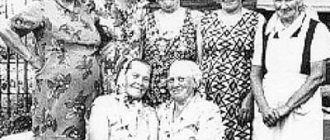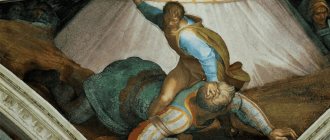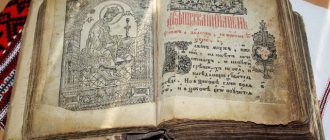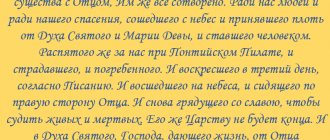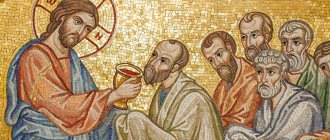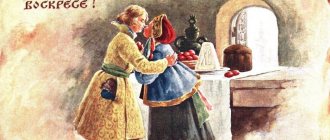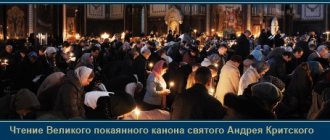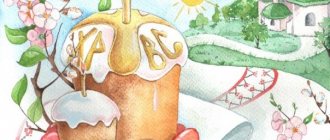How the Resurrection of Christ was celebrated in Rus'
Easter, the main Orthodox holiday, in folk tradition has also absorbed many pre-Christian practices. And if during Lent and especially during Holy Week (the last week before Easter Sunday) the way of life in the villages was almost the same from region to region, then for Holy Week (after Easter) each locality had its own ritual.
Left behind is Palm Sunday, when the willow with the first “lambs” was blessed in churches. Maundy Thursday passed, when everything in the hut was washed and scrubbed, and the housewives prepared Thursday salt for future use. And Good Friday, the day of the strictest fast, on which even babies were weaned, also ended. On Dyeing Saturday, rural Rus' painted eggs, and finally, on the night from Saturday to Sunday, after the all-night vigil, the long-awaited Easter arrived.
Stichera for Easter in the 5th tone, with the chant “Let God rise again” performed by O.P. Ovchinnikova from the city of Belovo, Kemerovo region
What are stichera
Stichera (from the Greek στιχηρόν - multi-verse) is a liturgical chant consisting of several verses, written, in the original, in one verse meter, sung during the service after verses from the Holy Scriptures.
The number of stichera at the All-Night Vigil depends on the holiday; the more important the holiday, the greater the stichera. Stichera are usually distinguished by the name of the psalms with which they are associated (stichera on “I cried to the Lord,” stichera on “Praise”), or by the place of their reading at the service (at the litia, at the stichera).
The first Gospel stichera (dated 1303)
The stichera of Easter consist of five troparia (stichera), which are preceded by individual verses from the psalms (the first verse is “Let God rise again...”, the last is “Glory even now”). There are only four verses, five stichera. The stichera of Easter end with the threefold singing of the troparion “Christ is Risen...”.
Stichera of Easter in Old Church Slavonic
May God rise again, / and let His enemies be scattered.
Easter / sacred has appeared to us today; / Easter is new holy; / Easter is mysterious; / All-honorable Easter. / Easter Christ the Deliverer; / Easter is immaculate; / Great Easter; / Easter of the faithful. / Easter opens the doors of heaven to us. / Easter sanctifying all the faithful.
Like smoke disappears, / let them disappear.
Come / from the vision of the wife of the gospel, / and cry to Zion: / receive / from us the joys of the annunciation, the Resurrection of Christ: / show off, rejoice / and rejoice, O Jerusalem, / having seen the King Christ from the tomb, / like a bridegroom coming.
So let sinners perish from the Face of God, / and let righteous women rejoice.
The Myrrh-Bearing Women, / in the deep morning, / appeared at the tomb of the Life-Giver, / found an Angel, / sitting on a stone, / and told them, / saying: / that you seek the Living One with the dead; / Why are you crying into the aphids? / Go and preach as His disciple.
This is the day the Lord has made, / let us rejoice and be glad on it.
Red Easter, / Easter, Lord's Easter! / All-honorable Easter / an opportunity for us. Easter, / let us embrace each other with joy. / O Easter! / Deliverance of sorrow, / for from the grave this day, / as Christ / has risen from the palace, / fill women with joy, saying: / preach as an apostle.
Glory to the Father and the Son and the Holy Spirit, now and ever and unto ages of ages. Amen.
Resurrection day, / and we will be enlightened by triumph, / and we will embrace each other. / Let us cry, brethren, / and forgive all those who hate us, / through the Resurrection, / and thus we cry: / Christ is risen from the dead, / trampling down death by death, / and giving life to those in the tombs.
Easter verses in Russian
May God arise and His enemies be scattered.
The sacred Easter has now appeared to us - a new, holy Easter, a mysterious Easter, an Easter revered by all. Easter - Christ the Redeemer; Immaculate Easter, Great Easter, Easter of the faithful (Christians), Easter which opened the doors of heaven to us, Easter which sanctifies all the faithful
May they disappear like smoke disappears.
Go after the vision, the wife of the gospel, and cry out to Zion: “Receive from us the joy of the gospel of the resurrection of Christ!” Rejoice, rejoice and rejoice, O Jerusalem, having seen the King Christ emerge from the tomb like a bridegroom.
So let sinners perish from the presence of God, and let the righteous rejoice.
Deep in the morning, the myrrh-bearing women, presenting themselves to the tomb of the Giver of Life, found an Angel sitting on a stone, and he, turning to them, proclaimed: “Why are you looking for the Living One among the dead? Why do you mourn the Imperishable One as one who has undergone corruption? When you return, tell His disciples!”
This is the day that the Lord has made; let us rejoice and be glad in it!
Good Pascha, Pascha, the Lord's Pascha, the Holy Pascha has dawned upon us. Easter! Let's hug each other joyfully. Oh, Easter - deliverance from sorrow! For from the tomb on this day, as if from the bridal chamber, having shone forth, Christ filled the women with joy with the words: “Tell the Apostles!”
Glory to the Father and the Son and the Holy Spirit, now and always and unto ages of ages:
Resurrection day! And we will shine with triumph and hug each other; let's say: "Brothers!" and we will forgive everything to those who hate us for the sake of the resurrection, and thus we will proclaim: “Christ has risen from the dead, having conquered death by death and giving life to those in the tombs, i.e. dead."
They will be scattered - they will be scattered; appeared - appeared; opening - opening; rtsyte—tell me; show off - rejoice; having seen - having seen; happening - going out; having presented - having presented; found; found; having preached - having turned; sitse - thus, thus; in on - in him; fulfill - fulfilled; let's hug - let's hug.
Roll, roll, egg
Three times kissing (baptizing Christ) and beating eggs as an Easter tradition have survived to this day. But the custom of rolling eggs is rarely seen anywhere now. Although this fun is very simple: you need to roll a colored egg along an inclined board or groove so that it knocks down the small objects laid out below. If it’s knocked down, they take the item for themselves. If not, the egg remains and can itself become a prize for another participant. However, it was quite possible to do without a board: the eggs were rolled both on the table and on the grass. Somewhere this children's entertainment was considered very respectable: in the Pechora region men rolled eggs, and sang a round dance song during this.
Round dance song for Easter “And a pine tree is at the gate, it grew long” performed by A.G. Kiseleva and K.V. Burlakova from the village of Lyubnitsa, Põlvas district, Estonian borderland
Women in this area had their own entertainment: they walked slowly through the streets, holding each other's arms. The boys and girls spent their time more dynamically: on the shore of the lake they swung on swings and danced in circles.
Round dance song for Easter “And how the thunder struck before the cloud” performed by A.G. Kiseleva, K.V. Burlakova and L.N. Burlakova from the village of Lyubnitsa, Põlvas district, Estonian borderland
What do the Easter stichera say?
Easter stichera consist of verses - excerpts from psalms - and texts dedicated to the holiday. The verses are taken from Psalm 67 of King David - the main prophecy about the resurrection of Christ ( first stichera ):
“May God rise again, and may His enemies be scattered, and may those who hate Him flee from His presence. As smoke disappears, let them disappear, as wax melts from the face of fire, so let sinners perish from the face of God, and let righteous women rejoice...” Between each phrase-verse there follows a hymn of praise to the holiday.
Of particular note is how often the word “Easter” appears in the text. This name of the holiday refers us to the history of the Old Testament. The word Passover has an ancient meaning (translation: “passed by”) and was originally associated with the Jewish holiday of the liberation of the people from 430 years of Egyptian slavery.
The prophet Moses comes to Pharaoh to beg him to release the Israelites, and is refused, for which God sends “ten plagues of Egypt” to the country: pestilence, plagues, springs filled with blood instead of water (Book of Exodus) and others.
But Pharaoh is not enlightened by these signs and does not give his permission. Then the Lord sends the most terrible execution - the angel of death descends on Egypt at night, taking with him every first-born Egyptian. The Lord said to the Israelites:
“You must have a lamb without blemish, male, one year old; take it from the sheep or from the goats, and let it be kept with you until the fourteenth day of this month: then let all the congregation of the congregation of Israel slaughter it in the evening, and let them take some of its blood and put it on both the doorposts and on the lintel of the doors in the houses where they will eat it; let them eat his meat this very night, baked on the fire; let them eat it with unleavened bread and bitter herbs; Do not eat it half-baked, or boiled in water, but eat it baked over fire, the head with legs and entrails; do not leave it until the morning [and do not crush its bones], but what remains of it until the morning you burn in the fire. So eat it this way: let your loins be girded, your sandals on your feet, and your staffs in your hands, and eat it with haste: this is the Passover of the Lord.”
Thus, the firstborn of Israel were saved from death, and every year the Jews celebrated this day. These ancient events have a prophetic meaning - the lamb that the Israelites consumed that night is a type of the Savior killed for the entire human race.
In addition, the events of Holy Week - the betrayal of Judas, the arrest of Christ, the Passion of Christ and the crucifixion - occurred on the eve of the Jewish Passover. And the Resurrection of Christ is on the night of Easter.
Therefore, the name of the Jewish holiday became the name of the Resurrection of Christ as the fulfillment of all prophecies.
The second text talks about the Gospel events - the meeting of the myrrh-bearing women with the Angels and with Christ - “Come from the vision of the woman who brought good news and cry to Zion.” The evangelist women are one of the closest disciples of Christ, the myrrh-bearing women (Mary Magdalene, Mary of Jacob, Salome, Susanna and others). “Roll Zion”:
Zion is the place where the apostles were hiding from the Jews at that time. Together with the angel-blasphemer, we tell the wives to go to them and tell them the good news about the Resurrection, we exclaim to all Jerusalem that it will meet the Savior as a bride meets her groom (“... show off, rejoice and rejoice in Jerusalem, having seen King Christ from the tomb, like a groom happening").
The comparison of the Savior with the groom follows from His Gospel parable of the ten virgins (“Then the kingdom of heaven will be like ten virgins, who took their lamps and went out to meet the bridegroom...” Matthew 25:1-13).
The third text of the stichera is similar in content to the second; it also tells about the appearance of an angel to the myrrh-bearers. “Why are you looking for Zhivago and the dead? Why are you crying incorruptible in aphids? Go and preach as His disciples,” is the phrase the Messenger greets them with. With these words he shows them that God is “the way, the truth and the life” (John 14:6), and death has no power over Him.
The fourth stichera , like the first, is a hymn to the bright holiday, it is “the guarantee of peace, the source of reconciliation, the extermination of enemies, the destruction of death, the destruction of the devil” (St. John Chrysostom).
The stichera on “glory and now” is the semantic and emotional culmination of the entire “cycle”. On this day we forgive our haters, as Christ taught in the Sermon on the Mount: “Love your enemies, bless those who curse you, do good to those who hate you, and pray for those who despitefully use you and persecute you” (Matthew 5:44). And the stichera ends with the singing of the troparion “Christ is Risen” - the central hymn of the Easter service.
All the texts harmonize with each other in a single emotional outburst, which is why the music (arrangement of the Znamenny chant), which came into use in church singing at Easter, represents a whole choral concert.
Dragging is always useful
In many villages, it was customary to go around the courtyards during Holy Week and congratulate the owners on Easter with the help of special songs. Such crawlers were called volochebniks.
The volitional song “Volochebniki, good people” performed by residents of the village of Gorodishche, Velizh district, Smolensk region
Franz Riess. Buffoons in the village. 1857
Walking tours could be made by anyone who wanted to get hold of something for the holiday: it was believed that such a visit promised good luck and prosperity to the owners. And it was customary to give thanks for him with food or even money. Therefore, both young and old people went to the courtyards, in some places only women, in others only men, and in others several Easter artels went around the village at once. They didn’t go alone: in this ritual choir everyone had their assigned roles. The leader was entrusted with starting the songs, and the others joined in. Those who did not have a voice, but could boast of a strong physique, became a fur bearer (wore fur, that is, a bag with the goods received). The repertoire of the volochebniki was rich and varied: there were separate congratulatory songs for the owners, for their sons, for unmarried girls and even for widows.
A walking song for a guy “What’s in the field, in the field and a herd of horses” performed by residents of the village of Zelenaya Roshcha, Pochepsky district, Bryansk region
A walking song for a girl “And early on Zoechka got up” performed by residents of the village of Zelenaya Roshcha, Pochepsky district, Bryansk region
Voluntary song for a widow “From under a steep mountain” performed by residents of the village of Zelenaya Roshcha, Pochepsky district, Bryansk region
This procedure was very reminiscent of Christmas carols. Despite the religious solemnity of Easter, the volochniks did not stand on ceremony with those who were in no hurry to load the furnace. Various reproaches could fall on the head of the tight-fisted owner.
Voluntary rooting song “Who won’t give you a testicle” performed by residents of the village of Azarovo, Pochepsky district, Bryansk region
To make the walk more fun, we took musicians with us. They, having stayed at home during Lent, eagerly took advantage of this opportunity to finally officially go wild. It is interesting that in some areas balalaikas and accordions were not held in high esteem. In the south of the Pskov region, for example, people walked around houses with cymbals and violins on Easter.
Violin tune “Volochebnaya” performed by I.P. Eroshenkova from the village of Savchenki, Kunyinsky district, Pskov region
Such rounds ended the same way everywhere: when the bag was full, the volochniks set the table and continued the holiday.
The volitional song “And the volochebnichki walked and walked” performed by residents of the village of Shumilovo, Velizh district, Smolensk region
